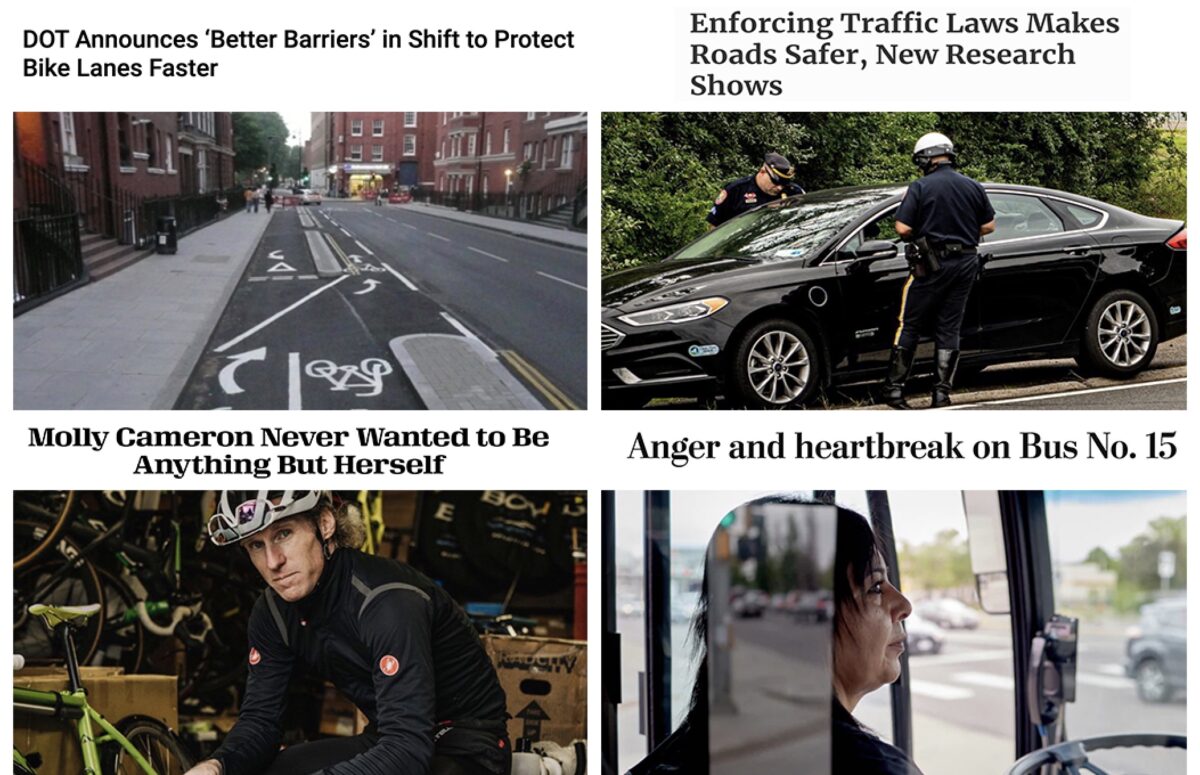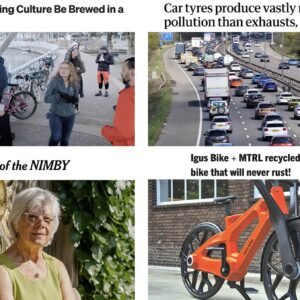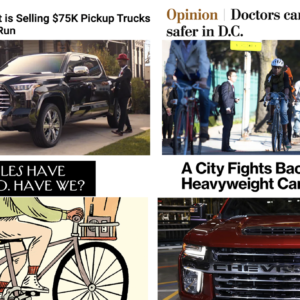
Welcome to the week.
Here are the most notable items our editors and readers came across in the past seven days…
Better barriers = better bike lanes: New York City’s transportation department has launched a new initiative to add more physical barriers to existing bike lanes in a shorter timeframe.
Deadly infrastructure: Chicago is reeling after two children under four were killed in preventable traffic crashes in just one week. On Thursday a woman carrying a three-year-old had to leave a bike lane to avoid a truck and crashed before the child was run over by a semi truck.
National spotlight: Local racer, business owner and activist Molly Cameron is the subject of a major feature story in Bicycling Magazine for her work in pushing for more inclusion of transgender athletes in cycling.
Bikebahn: Observers estimate as many as 30,000 people took part in a protest march on the autobahn in Berlin to push for better cycling infrastructure.
Behavior change: New research from NHTSA says that high-visibility traffic enforcement efforts can have a measurable impact on driver behavior and lead to safer roads for everyone.
Error prone: Local freeway fighting urban economist Joe Cortright lays out the many times the State of Oregon has failed to correctly estimate the cost of freeway megaprojects in his latest essay titled, “ODOT’s Reign of Error: Chronic highway cost overruns.”
High speed planning: Washington state will spend $150 million to plan their portion of a high speed rail line that would connect Portland to Seattle and British Columbia; but unless something changes it’s not like to be completed for another 20 years.
More Black people on bikes: Listen to this segment of Here & Now radio program about the growth of the Major Taylor Cycling Club in Kansas City, Missouri.
Flying with your bike: Here’s a thorough guide to taking your bike with you when you travel on an airplane.
A bus driver’s view: Absolutely wrenching and important story from WaPo about a bus driver in Denver who faces myriad urban ills on her daily route and struggles to withstand the emotional toll dealt by her riders.
Thanks to everyone who sent us links this week!






Thanks for reading.
BikePortland has served this community with independent community journalism since 2005. We rely on subscriptions from readers like you to survive. Your financial support is vital in keeping this valuable resource alive and well.
Please subscribe today to strengthen and expand our work.
Looks like Denver is another “paradise” like Portland. I really feel for these poor bus drivers.
I am sure this article is spot on with the issues this driver has faced, but anecdotally, I was all over Denver last week and there really is no comparison to Portland. The trash, tents and graffiti are so much worse here. Denver has a significantly larger bike path system and I saw nothing that would be even close to comparable to the conditions along the 205 path.
I noticed the same thing when I visited. To be fair, their harsh winter weather will ensure that they will never face the problems we have here.
incorrect, Reno has low 20’s those three months as well and have a look along the Truckee river and in the city plaza. No close proximity to Californication for Denver, Reno is a couple hours from Sacramento. . .
Average low temperatures:
City: Dec: Jan: Feb:
DEN: 19 20 21
PDX: 37 37 38
I was there last fall and the LODO area around their train station and transit center (pictured in the article several times) looked pretty much just like ours. The streets are lined with tents, unhoused folks suffering from addiction and/or mental health issues were yelling at each other and no one in particular, and injection drug use was out in the open. Saw the same thing in Seattle a few months ago. Friends in SF, LA, and Philly all say they see it there too. The article also mentions similar issues in Tucson and St. Louis.
It could be that this is all Joann Hardesty’s fault, or maybe there are some larger issues at play.
I vote for politicians to solve these issues or find the right people to solve them. It may not be any one politician’s fault, but their total lack of doing anything positive to help the folks that most need it is what is lacking from them.
I never expect them to solve these issues overnight, but to try one or more things that are more about helping people than getting them re-elected.
Our local politicians have 100s of millions of dollars at their disposal and what have they done to meaningfully help to reduce the Whellervilles and Kafourytowns that are all around us? How long have we had the so-called Housing Emergency? 10 years maybe? How many people have actually been helped off the streets and into permanent housing? A few hundred if any of the stats from the County and City are to be believed.
Full disclosure, I have never, nor never will vote for JH.
I wasn’t previously aware that JH runs TriMet. When did the city take over the bus service?
To a certain extent our transit services, buses, stops, and depots are extensions of the public realm, much like the sidewalk, parks, and bike paths. When I visit various communities and see well-cared for parks, I also typically see clean sidewalks, relatively clean (and unused) transit depots, clean and nearly empty buses, and not a lot of people on the street, be they homeless or office workers – basically everyone drives and I’m the odd tourist who isn’t driving. I’ve also been to many communities where everything is dingy and unkempt, both in small towns and large cities, and one wonders if the community has no pride, or is it simply broke? But most cities fall somewhere in between – some are pleasantly mediocre like the community I currently live in – and some are amazingly spotty, absolutely fabulous in some neighborhoods and truly awful in adjacent areas. Denver Line 15 is terrible, but are all the lines just as bad? To what degree does Line 15 reflect Denver?
In the same way the bus line up Williams doesn’t reflect Portland, the 15 doesn’t accurately reflect Denver.
Capitalism and its healthcare and shelter “free” markets.
So that’s why I noted I was there last week, and when comparing my recent regular visits to downtown Portland and last weeks visit to Denver, I concluded Denver looks far better. I did not say Denver is without issue, but this constant refrain from people here of, “ya know, this is happening everywhere” is pretty ridiculous. It may be in varying degrees, but Portland has some of the worst conditions and certainly one of the most pathetic responses anywhere in the country.
“It could be that this is all Joann Hardesty’s fault…”
It could NOT be that Joann Hardesty is personally uniquely responsible for all the conspicuous problems of Portland.
For instance, does any person think JH manufactures, imports, and distributes fentenyl? She does not.
Is JH to blame for a century or more of mistaken failed and egregiously racist drug laws? I believe that she omitted being born at the necessary time to pull that off.
Did JH operate a bulldozer to scrape off the Albina neighborhood? She did not.
Perhaps JH was a player in the Portland real estate market from 1930-2022 “…or maybe there are some larger issues at play.”
Nothing is all anyone’s fault; there are always “larger issues” at play. Everything has an infinitely complex web of causality.
None of that means that Hardesty has not taken ill-advised actions that have made our situation more difficult, such as damaging the relationship between the police and City Hall.
In other news, water is still wet. Film at 11:00.
The statistical analysis that comes out of our DOT always makes me want to jump out of a window.
I was fascinated to know how we could know that distracted driving rates decreased following increased enforcement efforts, for example. Had to go through 3 papers to get there, because the 80 papers quoted in the linked study aren’t directly cited. Turns out they measured how often cops saw people driving on their phones before & after cracking down with tickets. Issued by cops. That’s a horrible study design. Maybe people just got better at hiding it! Maybe the cops gamed it, since they’re both the group whose work is being evaluated and the group who’s measuring the outcome.
The study they cite directly includes linear regressions that show results from an entire study with one figure — a fitted line and alpha/beta values, without any observed data or residuals shown. Give me a break! What if a first degree linear regression is a bad model? I can’t know because they withhold the data I’d need to judge for myself. And again, the relationship is between how many checkpoints cops set up and how many transgressions they observe, this time with seatbelts.
Wouldn’t pass peer review even in the most lightweight journals.
High speed rail is great and all, but really expensive and way out in the future. An incremental step would make more sense. We could build dedicated right of way for the existing Cascades service that would allow the rolling stock that we (the taxpayers of Oregon, Washington, and BC) already own to be used to its fullest and not have to wait behind freight trains. That would be way cheaper, and could be done some time in my lifetime. It would take a bit longer than true high-speed rail, but would be much faster than driving.